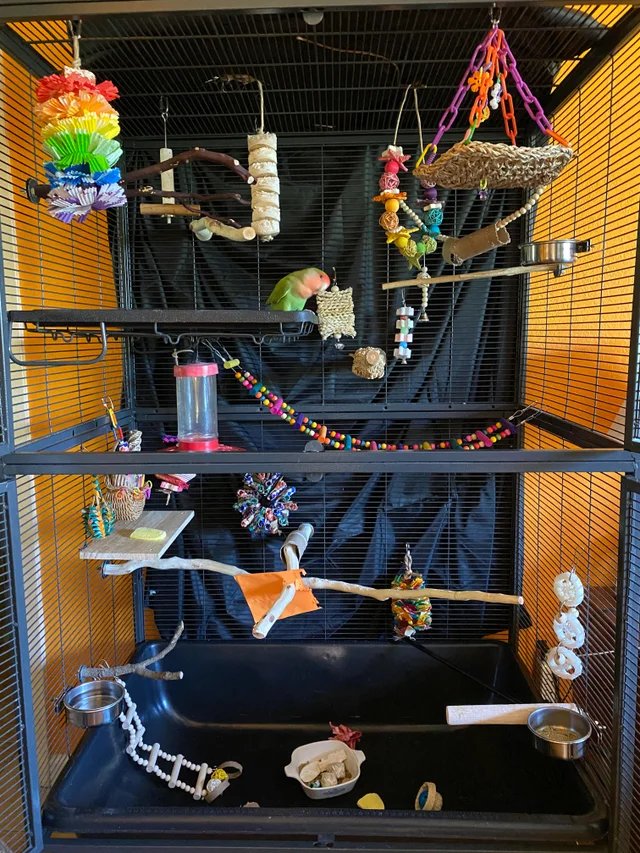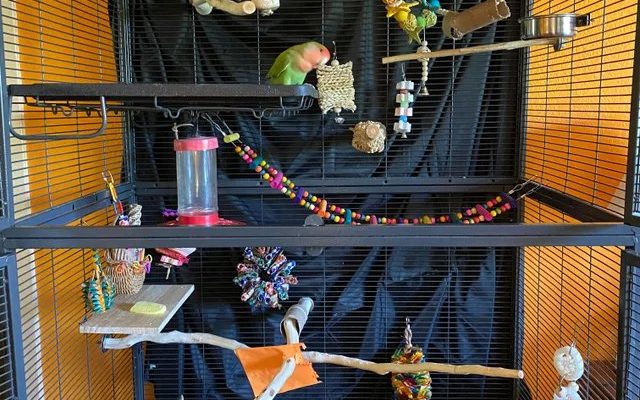
Cage Size: How Big Is Big Enough?
Choosing the right cage size is crucial for your lovebirds’ happiness. A cramped space can lead to stress and behavioral issues. Ideally, the cage should be at least 24 inches long, 18 inches wide, and 24 inches high for a pair of lovebirds. However, bigger is always better! If you can provide more space, your birds will have room to spread their wings and explore.
When selecting a cage, think about how active your lovebirds are. They’re energetic little creatures, and they love to fly around, even within a confined space. A larger cage allows for more climbing structures and toys, which keeps them engaged and physically fit. After all, a well-exercised lovebird is a happy lovebird!
It’s also essential to consider the bar spacing. For lovebirds, the spacing should be about ½ inch to ¾ inch apart. This prevents them from getting stuck or escaping, which is something no pet owner wants to deal with. So, when you’re shopping around, keep an eye out for these sizes!
Choosing the Right Perches
Perches are an essential part of your lovebird’s home, providing spots for resting and play. When picking perches, think variety! Different shapes and materials are key to keeping their little feet healthy and happy.
You might want to include natural wood perches that offer a variety of diameters. These provide a perfect texture for gripping and help exercise their feet. Remember, lovebirds like to explore, so offering different heights can spark their curiosity.
Here are a few types of perches to consider:
- Natural Branches: These mimic their natural habitat and are great for foot health.
- Sandpaper Perches: They help keep their nails trimmed but should be used sparingly to avoid foot injuries.
- Platform Perches: These provide a resting spot and can be a fun area for social interaction.
Mixing different perch types and sizes will create an exciting climbing landscape. Just make sure the perches are securely attached, so they don’t wobble when your little friends hop around!
Adding Fun and Engaging Toys
Toys play a major role in keeping your lovebirds mentally stimulated. Just like kids need playtime to grow, lovebirds require toys to engage their minds and exercise their bodies. A variety of toys will keep your feathered friends entertained and prevent boredom-related behaviors.
Here are some toy types you should consider:
- Chewing Toys: Lovebirds enjoy nibbling! Wooden chew toys or natural fibers are perfect for this.
- Foraging Toys: These challenge your lovebirds to work for their treats, mimicking natural behaviors.
- Swings and Ropes: Perches in the form of swings can provide both exercise and fun!
When introducing toys, rotate them regularly to keep things fresh. Imagine how exciting it must be for them to discover a “new” toy every few weeks. Also, make sure all toys are bird-safe, free from toxic materials, and sturdy enough to withstand their playful beaks.
Essential Accessories for Comfort
Creating a cozy environment goes beyond just toys and perches. You’ll also want to include some accessories to help your lovebirds feel secure and comfortable. Think of these accessories like the cozy throws and cushions we all love in our living rooms.
Nesting areas are essential for lovebirds, especially if you plan on breeding them. A small enclosed space, like a nesting box, gives them a sense of security. Even if they’re not breeding, a cozy spot can be a favorite hangout.
Next, consider adding food and water dishes. Opt for shallow, stable dishes to prevent spills and ensure easy access. It’s essential to keep these clean and fresh, as lovebirds can be picky eaters!
Lastly, think about including a calcium block or cuttlebone. Lovebirds need calcium for healthy bone development, and these can provide a natural way to meet that need. You might find your birds nibbly on them, keeping both their beaks and bones strong.
Location and Placement of the Cage
Now that you have the perfect cage and accessories, where should you place it? The location is just as important as the setup itself. Ideally, the cage should be in a lively area of your home where your lovebirds can see and interact with family members.
However, keep them away from direct sunlight and drafts. Too much sun can make the cage uncomfortably hot. On the flip side, drafts can be chilling for these small birds. An ideal spot would be in a room that gets a good mix of natural light without being too harsh.
Also, think about the height of the cage. Placing it at eye level helps your lovebirds feel part of the family. Plus, it makes it easier for you to check on them and enjoy their antics throughout the day!
Maintaining a Clean Environment
A clean cage is a happy cage, and this is crucial for your lovebirds’ health. Regular maintenance ensures that your pets stay in a safe and pleasant environment.
Start by spot-cleaning daily. Remove any uneaten food, droppings, or old toys. This helps prevent odors and keeps pests away. A thorough cleaning of the entire cage should happen at least once a week.
During this deep clean, remove everything from the cage, including perches and toys. Use a mild, bird-safe cleaner to wipe down the cage. Rinse thoroughly to remove any residues. Replace the bedding or liner at the bottom, and put everything back in a tidy manner, ensuring it’s safe and secure.
By maintaining a clean space, you’re not just keeping things tidy; you’re promoting healthy habits for your lovebirds.
Investing in a Good Quality Cage
Lastly, let’s talk about the quality of the cage itself. When it comes to setting up a lovebird’s home, investing in a sturdy and safe cage is worth every penny. Cheap cages may seem tempting, but they often lack the safety features and durability that more reputable brands offer.
Look for a cage made of non-toxic materials, with easy-to-clean surfaces and secure latches. A good cage will last you a long time and provide a stable environment for your lovebirds to thrive.
If you can, choose a cage designed specifically for small birds. This often means better spacing and support for their little bodies. Think of it as their own little palace, where every corner matters for their happiness.
In conclusion, setting up a lovebird cage involves much more than just the basics. It’s about creating a stimulating, safe, and beautiful environment where your vibrant friends can flourish. By carefully considering the size, perches, toys, and overall layout, you’re not just providing a cage; you’re crafting a home filled with love and joy. So, let your lovebirds explore, swing, and play, knowing they’re in a space made just for them!

